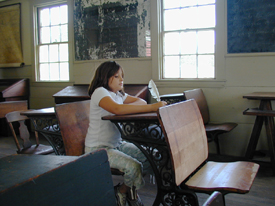by Holly Hartman
In 1768, when Putterham School opened, its first students were British subjects. That autumn, British troops arrived in the colony, heightening tensions that led to the Boston Massacre less than two years later. "Current events become history in this school," says Elln Hagney, curator of Putterham School. "When George Washington was fighting at Dorchester Heights, there were kids learning in this classroom. When Lincoln was signing the Emancipation Proclamation, kids here were studying it as a current event." When the one-room school closed in 1922 - more than 150 years later - its 15 students may have been discussing the aftermath of World War I, or how American women had finally won the vote.
Last year, about 1,000 visitors explored the small wooden schoolhouse, thanks to regularly scheduled tours by the Brookline Historical Society. "People were so excited to see it open," Hagney says. "It was incredible to see people connect immediately with that building." Hagney believes that visitors connect with "a common experience - we all had to go to school... You walk into this school and you're put in a time and a place. You smell it, you feel it. It appeals to the senses."
The familiar set-up of Putterham School, with its neat rows of sun-splashed desks, reflects an era of innovation. By the mid-1800s, educators such as Horace Mann, secretary of the Massachusetts Board of Education, had enlightened the public about the importance of schoolchildren having access to sunlight, fresh air, and individual workspaces. In 1854, a Brookline committee warned that at Putterham School, "the ceiling is so low, and the building so ill-ventilated, that it is unhealthy" for students, who sat on "uneasy plank structures" rather than at desks. The following year, the town raised the ceiling 18 inches, enlarged the windows, and brought in desks and chairs. Twenty-nine children were then enrolled.
By the late 1800s, the modest schoolhouse was becoming a relic of suburban Brookline's agricultural past. The Brookline school superintendent's 1895 report called the school "a connecting link between the present day of wealth and progress and the primitive days of simplicity and poverty." The application of fresh canvas wallpaper soon afterward resulted in an unintentional bit of preservation - a chalkboard lesson by Miss Mary Elizabeth Hyde, dated October 18, 1897. Uncovered more than half a century later, the lesson is now one of the evocative artifacts at Putterham that, in Hagney's words, help visitors "lift the veil of history" and "immerse themselves" in the past.
Those who wonder what life was like at Putterham have a rich source: a former student of Miss Hyde, Florence Palmer Peabody, who in 1959 wrote an article titled, "When I Went to School." Peabody described her years at Putterham as "some of the happiest and most worthwhile" of her education. In her memory, nearly two dozen children "worked and played together as one big, happy family" at the one-room school. Peabody recalled the school's barrel stove and woodshed, outdoor privies, bucket of drinking water, and rustic hooks on which children hung their coats. Despite these simple facilities, Peabody experienced Putterham as "a most cosmopolitan school, four or five nationalities being represented in its membership (most of the parents being recent immigrants to this country)."
One such child of immigrants was Putterham's best-known alumnus, golf champion Francis Ouimet, who attended the school from 1900 to 1906. During this time he began caddying at the nearby Country Club. On that same course, Ouimet - a self-taught American amateur in a sport dominated by wealthy British pros - later turned the golf world upside down by winning the 1913 U.S. Open.
In 1966, the Brookline Board of Selectmen and the Brookline Historical Society had the disused schoolhouse moved from its original location, near the intersection of Newton and Grove Streets, to Lars Anderson Park. It became part of what Hagney calls "a cultural complex within town," which includes the auto museum, the ice skating rink, and the park itself. Today Putterham School rests on a fieldstone foundation alongside a low, wooded hill, just as it did at its original site.

